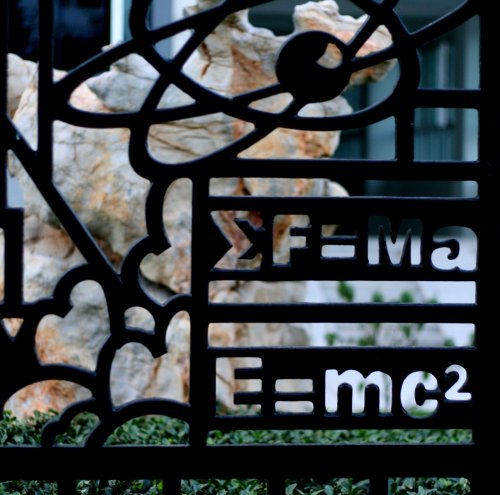|
HOME
for more info
click here
BOOKS
for more info
click here
back
to
ARTICLES
for more info
click here
POEMS
for more info
click here
SHORT
STORIES
for more info
click
here
BLOGS
for more info
click here
BIBLE
STUDIES
for more info
click here
FAVORITE
THINGS
for more info
click
here
Contact
me
click here Picture
Attributions -
physics: kouchi
fractal: SantaRosa
fern: Kathryn
snowflake: SantaRosa
thought: winjohn
Affiliates
-

Where authors and readers come together! |
|
|
|
|

|
Fractal
Dimensions –
Twilight Zone?
No, Nature!
|
|
|
|
|
|
Familiar with one, two, and three dimensions? What
about dimensions of 0.63 or 1.26?
It’s not science fiction, but quite natural. Read on...
|
|
|
|
|
|
A group of
scientists is calculating how fast a chicken can fly.
The physicist begins – “Let us first assume a spherical
chicken …”
This is a
favorite punch line of physics jokes.
What brings a
smile to the face is that the joke makes a point about the absurdity
of some assumptions. The
real world is not nice and smooth and symmetrical, like straight
lines, circles, squares, spheres, cubes, and such.
If it were, it would greatly simplify calculations.
The French
mathematician Benoît Mandelbrot was one of the first to bring fractal
geometry to our consciousness, which can be used to describe
nature more accurately. He
coined the term, “fractal,” derived from the Latin fractus
meaning “broken” or “fractured.”
A fractal can be
defined as having the following features:
It
is too irregular to be easily described in traditional Euclidean
geometry.
It
is self-similar (at least approximately).
It
has a fine structure at arbitrarily small scales.
It
can have a dimension which is greater than its topological
dimension.
It
has a simple and recursive definition.
Natural objects
that approximate fractals include clouds, mountain ranges, lightning
bolts, coastlines, snow flakes, tree leaves, the convoluted surfaces
of our brains, even some of the vegetables we eat.
Cauliflower, for
example, has a feature of self similarity.
The whole cauliflower has a defining shape. Yet,
if you break off a branch, you see the same type of shape as the
whole cauliflower. Likewise,
one of the flowers on the branch has the same type of shape as well.
And so on …
|
|
|
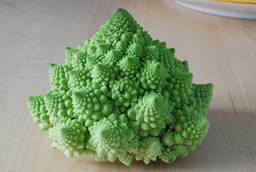
Picture and license agreement for use
from Wikimedia Commons: http://en.wikipedia.org/wiki/Image:Cauliflower_Fractal_AVM.JPG
|
|

|
Ferns are fractal in nature and can be modeled on a computer by
using a recursive algorithm. For
example, a frond from a fern is a miniature replica of the whole.
|
|
|
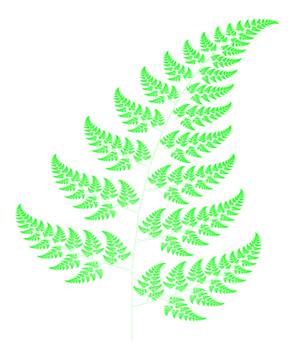
Picture and license agreement for use from
Wikimedia Commons: http://en.wikipedia.org/wiki/Image:Bransleys_fern.png
|
|
|
One of the features of fractal
geometry is its fractal
dimension – the measure of a set of points that characterizes
its space-filling properties. To
get a handle on fractal dimensions, familiar Euclidean objects will
be discussed, and then some examples of fractals.
|
|
|
Objects
of one, two, three dimensions:
Take an object
(line, square, or cube) residing in a space of dimension, D.
Reduce its linear size by 1/l in
each spatial direction. As
l
increases, the number, N, of objects (lines, squares, or cubes) to
fill the space increases as N = l D.
|
|
|
Picture and public domain info from Wikimedia
Commons: http://en.wikipedia.org/wiki/Image:Fractaldimensionexample.PNG
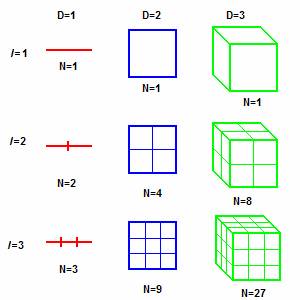
…
l
= n
N =n1
N = n2 N
= n3
|
|
|
Fractal
dimensions:
There are many
definitions of a fractal dimension and none of them should be
treated as the universal one. I
will concentrate on the capacity
dimension, Dcap.
Consider D
= log(N)/log(l).
For D, take the
limit as 1/l
→ 0 to reduce its linear
size in each direction to be infinitesimally small (hence, take the
limit as l
→ ∞):
Dcap
= lim l
→∞ log(N)/log(l).
With this
definition, the capacity dimension, Dcap, need not be an
integer. It can be a
fraction or an irrational number, as we shall see.
First, Dcap
will be applied to familiar 1, 2, and 3 dimensional objects –
lines, squares, cubes – then to fractals.
One
dimension:
Consider a line
of finite length. Reference
previous figure for D = 1.
l
= n. The first length is
reduced by 1/2. Next
length is reduced by 1/3. …
The nth length is reduced by 1/n.
N = n, number of lines that fill the space.
Dcap =
lim l
→∞ log(N)/log(l).
Dcap = lim n→∞ log(n)/log(n)
Dcap = 1
So, the capacity
dimension of a line is one. No
surprise, here.
Two
dimensions:
Consider a
square of finite area. Reference
previous figure for D = 2.
l
= n. The first square is
reduced by ½ in each direction.
The next square is reduced by 1/3 in each
direction. … The nth
square is reduced by 1/n in each direction.
N = n2, the number of squares that fill the space.
Dcap =
lim l
→∞ log(N)/log(l).
Dcap = lim n→∞
log(n2)/log(n) = lim n→∞ 2 log(n)/log(n)
Dcap = 2
So, the capacity
dimension of a square is two. Again,
no surprise.
Three
dimensions:
Consider a cube
of finite volume. Reference
previous figure for D = 3.
l
= n. The first cube is
reduced by ½ in each direction.
Next cube is reduced by 1/3 in each direction. …
The nth cube is reduced by 1/n in each direction.
N = n3, number of cubes that fill the space.
Dcap =
lim l
→∞ log(N)/log(l).
Dcap = lim n→∞ log(n3)/log(n)
= lim n→∞ 3 log(n)/log(n)
Dcap = 3
So, the capacity
dimension of a cube is three. The
trend is obvious.
Fractal
dimensions:
Capacity
dimension becomes more interesting and complex when dealing with
fractals.
Cantor
set example:
To create a
Cantor set, start with a line. Next
iteration, remove the middle third of the line.
In the resulting 2 lines, remove the middle third of each
line. In the resulting 4
lines, remove the middle third of each line. ...
In the resulting 2n lines, remove the middle third
of each line.
|
|
|
Picture and public domain info from Wikimedia Commons:
http://en.wikipedia.org/wiki/Image:Cantor_set_in_seven_iterations.svg
|
l
=
|
Cantor
Set
|
N
=
|
|
1
3
9
27
81
243
|

|
1
2
4
8
16
32
|
|
3n
|
….
|
2n
|
|
|
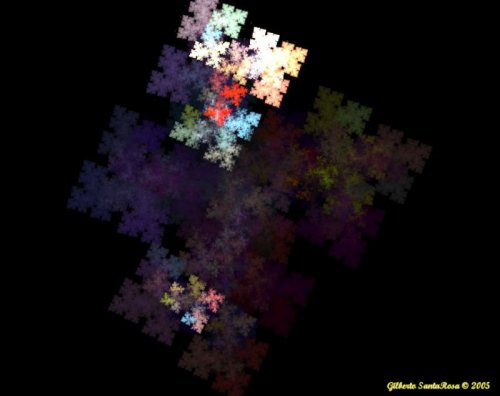
|
l
= 3n. First
line is reduced by 1/3 its original length.
Next line is reduced by 1/9 its original length.
… The nth line is reduced by 1/3n its
original length.
N = 2n , number lines to fill the set:
1 line, 2 lines, 4 lines, …, 2n
lines.
Dcap =
lim l
→∞ log(N)/log(l).
Dcap = lim n→∞
log(2n)/log(3n) = lim n→∞
( n log(2) ) / (n log(3) ) = log(2) / log(3)
Dcap = 0.6309 …
In the Cantor set as l
→ ∞, we have an object with a dimensionality less than
one, approximately, 0.6309.
Koch
snowflake example:
Another example
of a fractal is a Koch snowflake.
Start with an equilateral triangle.
Next iteration, remove the middle third of each line in the
triangle, and replace it with two lines, in which each has the same
length (1/3) as the remaining lines.
For the following iterations, for each line, repeat the
previous process. For
each successive iteration, the number of lines on each side of the
Koch snowflake increases by a factor of 4.
|
|
|
Picture and
license agreement for use from Wikimedia Commons:
http://en.wikipedia.org/wiki/Image:KochFlake.svg
|
l
=
|
Koch
Snowflake
|
N
=
|
|
3
9
27
81
|
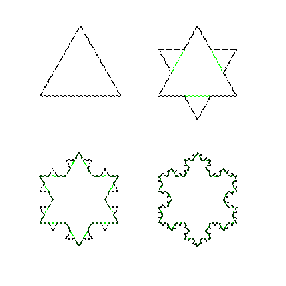
|
3
3 · 4
3
· 16
3 · 256
|
|
3n
|
|
3
· 4n
|
|
|
|
l
= 3n. First
line is reduced by 1/3 its original length.
Next line is reduced by 1/9 its original length. … The nth
line is reduced by 1/3n its
original length.
N = 3 · 4n , the number of lines that comprise the
perimeter of the snowflake, which is three multiplied by a factor of
4 for each successive iteration.
Dcap =
lim l
→∞ log(N)/log(l).
Dcap =
lim n→∞ log(3 · 4n)/log(3n)
Dcap = lim n→∞
( log(3) + n log(4) ) / n log(3)
Dcap = lim n→∞
( log(3))/n log(3) ) + lim n→∞ ( n log(4) ) /
(n log(3) )
Dcap =
log (4) / log (3) =
1.2618…
For the Koch snowflake
as l
→ ∞, we have an object with dimensionality greater than
one but less than two, approximately 1.2618.
To see a dynamic creation of a Koch snowflake, check out:
Some applications of fractals:
For the Koch Snowflake as n→∞ its perimeter
becomes infinite, though the perimeter clearly encompasses a finite
area.
Iteration
|
Perimeter
length
|
1
|
3
|
2
|
3
· 4/3
|
3
|
3
· 16/9
|
4
|
3
· 64/27
|
…
|
…
|
n
|
3
· 4n/3n
|
…
|
…
|
∞
|
∞
|
Coastline example:
The model of the perimeter of a Koch snowflake can be
applied to coastlines.
Mandelbrot began his
treatise on fractal geometry by considering the question: “How
long is the coast of Britain?”
|
|
|
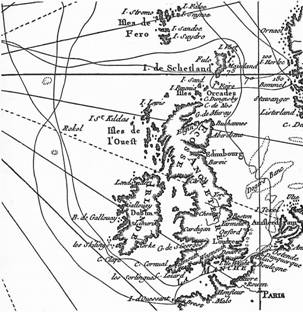
Picture and public domain info from
Wikimedia Commons: http://commons.wikimedia.org/wiki/Image:Rockall_Kerguelen_map_1771.jpg
|
|
|
The coastline, as we
see, is irregular, whether we have the view from a satellite or the
microscopic view of its shoreline.
If we measure the coastline with a straight ruler, we get an
estimate, which is the length of the ruler multiplied by the number
of such rulers needed to cover the perimeter. As
the size of the rulers shrink, the length of perimeter gets
infinitely large, much like the perimeter of a Koch snowflake.
The length of the coastline of Britain could be considered to
have a fractal dimension somewhere between 1 and 2.
Wadded up paper example:
Who hasn’t
taken a piece of paper, crumpled it up, and tossed it in the waste
basket? This is another
example of an object which approximates a fractal.
The paper can be considered two dimensional.
Wadded up, it appears to be a spheroid shape, with irregular
gaps. Is the wad of
paper 2 dimensions or 3? Fractal
geometry suggests its fractal dimension is somewhere between 2 and
3.
Conclusions:
I’ve just
barely broached the subject of fractals, fractal geometry, and
fractal dimensions. Fractals
are a useful model of the natural world, which can be applied in
many branches of science and can be a powerful approach to analyze
the complex systems around us.
|
|
|
|
|
© November 7, 2008, S. K. Smith
|
|
|
|
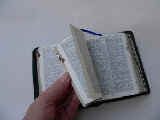
|
Thought: Words
about fractals in nature -
"Canst thou lift
up thy voice to the clouds,
that abundance of waters
may cover thee?
Canst thou send
lightnings,
that they may go and say
unto thee, Here we are?"
Job
38: 34, 35 (KJV)
|
|
|
|
|
|
